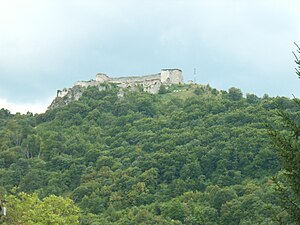Ostrovica Castle
| Ostrovica Castle | |
|---|---|
| Ostrovica, Bosnia and Herzegovina | |
 Ostrovica Castle | |
| Coordinates | 44°33′29″N 16°04′52″E / 44.558°N 16.081°E |
| Type | Hilltop castle |
| Site information | |
| Controlled by | Disislavić noble family, Kurjaković noble family (later renamed Karlović), Juraj Mikulčić, Ivan Keglević, Frankopan noble family |
| Condition | damaged, partially renovated |
| Site history | |
| Built | 15th century |
| Built by | (unknown) |
| Materials | hewn stone (ashlar) |

The Ostrovica Castle (Template:Lang-sh; Ottoman Turkish: Ostroviçe kalesi) is a large medieval structure situated above the small village of Ostrovica near Kulen Vakuf, Bihać municipality, Bosnia and Herzegovina. Having been built on a woody ridge of a steep hill overlooking left bank of the shallow Una river, the castle was located on a strategic site connecting the northern and southern parts of the long Una valley.
The modern-day castle was most probably built during the 15th century on the foundations of ancient fortification which dates back to ancient Roman times or even earlier.[1]
History
This section needs additional citations for verification. (June 2020) |
In the Middle Ages, Ostrovica belonged to the Kingdom of Croatia and its Lapac County. First Mentioned in 1407[2] when Ladislaus I confirmed the fortress as the property of Duke Sandalj Hranic, given as a dowry for his wife Katarina Vukčić Hrvatinić. It was possessed by the Kurjaković family, (later renamed Karlović), known as Princes of Krbava (Template:Lang-hr), who came out from one of chieftain cadet branches of the old Croatian tribe of Gusić. After them, proprietors of the castle were also Juraj Mikulčić (who died in 1495), Ivan Keglević, and members of House of Frankopan, among others.
The Ottoman threat to Ostrovica began after the fall of the medieval Kingdom of Bosnia in 1463. Still, the castle resisted until December 1523, when the castle and surrounding area came under Ottoman control.[citation needed]
The long period of Ottoman rule lasted until 1878. In that period the castle was enlarged and reinforced, serving as an Ottoman military stronghold. Military units situated there were commanded first by dizdar (16th and 17th century) and then (from the beginning of the 18th century) by a captain.[citation needed]
A significant enlargement of the castle occurred during the reign of sultan Ahmed I at the beginning of the 17th century. The present-day look of the castle was finally given at the beginning of the 18th century. It measures 117 meters long and 83 meters wide. The main entrance is situated on the south side, while the auxiliary one is put at the north side of the fortification.[citation needed]
During the Ottoman period Ostrovica was the seat of Kapetanija Stara Ostrovica (Old Ostrovica captaincy), also comprising smaller strongholds like Orašac, Havala, Džisri-kebir (modern-day Kulen Vakuf), Čovka and Donji Lapac. Long-term captains were members of the Kulenović noble family (titled begs), one of the most prominent families in Ottoman Bosnia.[citation needed]
After Donji Lapac had been returned to Croatian control (being within Habsburg Monarchy), the Ottomans moved the seat of captaincy away from the nearby Croatian-Bosnian frontier to Prkose, a stronghold in the same-named village, situated northeast of Ostrovica.[citation needed]
In 1737, the fort was unsuccessfully besieged by the army of the Habsburg Empire during the Austro-Russian–Turkish War (1735-39).
The Austrian Empire took over governing Bosnia and Herzegovina in 1878, but despite Croat demands, Ostrovica was not returned to the Croatian Kingdom, of which it had been part before the arrival of Ottoman Turks. Moreover, the whole territory of Turkish Croatia, including Ostrovica, Bihać, Banja Luka and so on, was given to direct Habsburg imperial control, as a part of Bosnia and Herzegovina.[citation needed]
Today the castle and its surroundings belong to the Una National Park, being occasionally renovated in the recent years in order to be more attractive to tourists.[1]
See also
- List of fortifications in Bosnia and Herzegovina
- History of Bosnia and Herzegovina
- Kingdom of Croatia (1102–1526)
References
External links
- History of Ostrovica Castle in Croatian Encyclopedia of the Miroslav Krleža Lexicographical Institute in Zagreb
- Ostrovica Castle built above left bank of the Una river
- Ostrovica – medieval and Ottoman castle
- Ostrovica was possessed by a branch of Gusić family from Lika and Krbava
- Members of the Kulenović family were Ottoman captains of Ostrovica
- Reconstruction of the castle
- Northern tower renovation works


